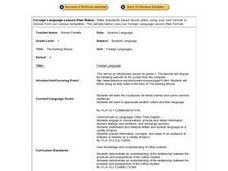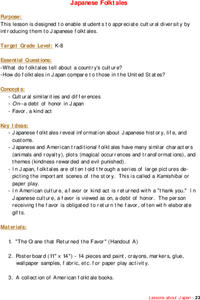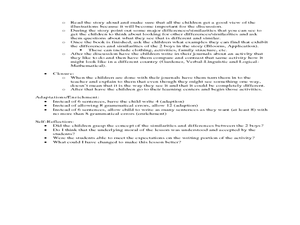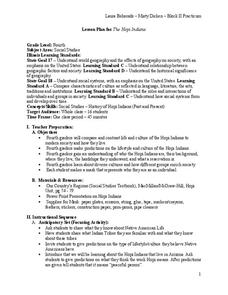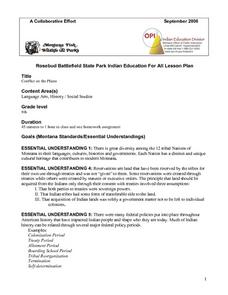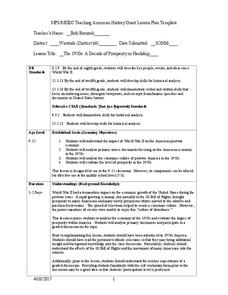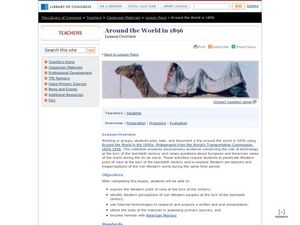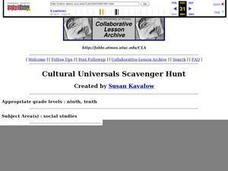University of the Desert
A Plan For Positive Action
Can one person really make a difference? As the culminating instructional activity in a twelve-part series, learners discuss how they can partake in an intercultural dialogue that can have a lasting impact on the global community, and...
US Institute of Peace
Responding to Conflict: Active Listening
Did I hear you right? You need a great lesson on active listening? Through large- and small-group activities, learners differentiate between poor and excellent listening skills. The resource, 7th in a series of 15, focuses on active...
Curated OER
The Banking Mouse
First graders learn about another culture and its language. In this Spanish lesson, 1st graders listen to a Cuban folktale. Students identify the Spanish words. Students reread the story independently. Students listen to a guest...
Curated OER
Personality and Posts
Students examine the personality type needed to become a diplomat in the US Foreign Service. They look at the results of the Myers-Briggs Personality Test that each diplomat in training must take. They study their own personality type to...
Curated OER
Reading Artifacts
Students explore and analyze categorizing objects, material culture artifacts, from a variety of perspectives, to consider the story behind each one. They research skills by assessing how to look at artifacts as cultural outsiders would....
Curated OER
American Deaf Culture: Deaf Art
Students examine the culture and art of the Deaf Community. They discover the history of the Deaf Community using art and their values. They compare and contrast different pieces of art.
Curated OER
Japanese Folktales
Students identify that Japanese folktales reveal information about Japanese history, life, and customs. Students identify and interpret the work kamishibai, paper play and explain that in Japanese folktales are told through a series of...
Curated OER
Design a Latin American Restaurant
Students investigate the culture of a Latin American country to design a new restaurant. In this Latin American lesson, students identify social classes, geographical locations, cultural practices, and monetary systems of a Latin...
Curated OER
Spanish/American Comparison
Students compare Spanish and American cultures. For this global studies lesson, students review what they have learned in a Spanish culture unit by writing compare and contrast essays about Spanish and American cultural aspects.
Curated OER
Culinary Diversity
Students discover foods associated through different cultures and how they came about. In this food culture lesson, students investigate the different influences on the diets of different people based on their heritage. Students...
Curated OER
Multiple Viewpoints
First graders explore the concept of multiple viewpoints. In this perspective lesson, 1st graders discuss the differences and similarities found within different cultures. Students then write a narrative about how something they can do...
Curated OER
The Hopi Indians
Fourth graders make a mask of who they are as an individual after studying the Hopi Indians. In this Hopi Indians lesson plan, 4th graders compare and contrast the Hopi life with theirs, make predictions, and learn about culture.
Curated OER
The Hopi Indians
Fourth graders read and look at maps of the Hopi Indians and compare and contrast their lives with the Hopi Indians. In this Hopi Indians lesson plan, 4th graders learn about different cultures and answer short answer questions.
Curated OER
China
Second graders complete a variety of activities surrounding a unit on China and Chinese culture.
Curated OER
United States & Canada: How Are We The Same? How Are We Different?
Pupils compare and contrast similarities and differences between Canada and the US. In this geography lesson, students read various articles and identify similarities and differences in economies, cultures, geography, climate, and...
Curated OER
Conflict On The Plains
Eighth graders investigate the culture and lifestyles of the Lakota Sioux and the Northern Cheyenne tribes. They use a variety of resources for research. They create questions based on information to be used during classroom discussion...
Curated OER
American Economics after WWII
Students analyze the American culture after WWII. Through a variety of activities, students gain an understanding of ecomonics and prosperity in the US following WWII.
Curated OER
Slices of American Pie: The 1960s Through Music
Eleventh graders examine political, cultural, and social movements through music. For this 1960s American history lesson, 11th graders explore the music of the decade in order to better understand the complexity of the time period....
Curated OER
Around the World in 1896
Young scholars work in groups to plan, take and document a trip using an Internet Database of primary sources "Around the Wolrd in the 1890's." This enables students to break old western perspectives of other nations as they analyze...
Curated OER
Celebrating Connections
Third graders examine religious traditions and celebrations. In this Social Studies lesson, 3rd graders compare and contrast different religions. Students research a specific religion and prepare a presentation for the class.
Curated OER
Diversity: Origin Myths
Fifth graders analyze origin myths and the diversity of First Nations groups. In this history lesson, 5th graders review the geography of Canada and read various origin myths. Students illustrate one of the myths and research others in...
Curated OER
Chinese Inventions
Learners identify inventions as coming from China. In this Chinese inventions lesson, students are given a list of common items such as cast iron, a wheelbarrow, and the decimal system, then conduct research to identify where they were...
Curated OER
Lessons for Atlatl Users with Some Experience-Grade 5
Fifth graders throw darts, collecting data for distance traveled. For this data analysis lesson, 5th graders throw a dart using an atlatl. They calculate the speed for each throw and determine the best dart length for distance throws.
Curated OER
Cultural Universals Scavenger Hunt
Young scholars search the web for three NON-WESTERN pictoral examples of each cultural universal. Students copy the photos onto a disc and arrange them using Microsoft Word or PowerPoint. Young scholars title each universal and add a...




